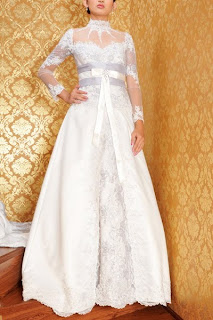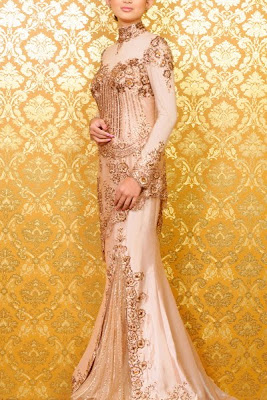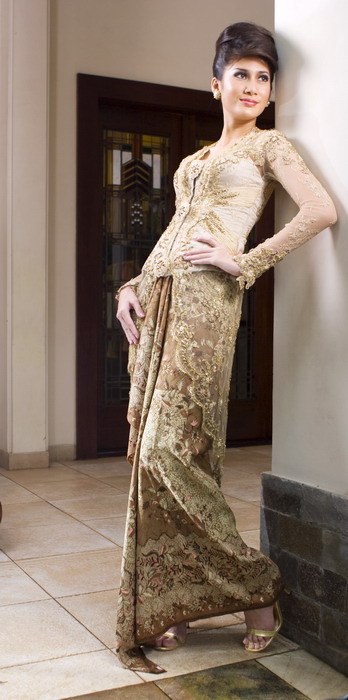As with all types of clothing, the wedding dress has changed in style and fashion throughout the ages. During the medieval period, when a wedding was a matter of politics above all else, brides had to dress in a way that would best reflect their families. The higher the social standing of the bride, the richer the colours and the more expensive the fabrics used. Fur, velvet and silk were often incorporated into the design. The styles and colours of the wealthier brides were copied by the brides of lower social standing as best as they could. Even though centuries passed and styles came and went, brides continued to dress in the most fashionable clothes, made from the richest and boldest materials that money could buy. Another factor indicative of the wealth and social standing of the bride was the amount of material used. Those who couldn't afford anything new wore their best church dress on their wedding day.
Even though centuries passed and styles came and went, brides continued to dress in the most fashionable clothes, made from the richest and boldest materials that money could buy. Another factor indicative of the wealth and social standing of the bride was the amount of material used. Those who couldn't afford anything new wore their best church dress on their wedding day.
In the 1920s fashion dictated that wedding dresses be shorter in the front than at the back and that they have a long train. They were worn with cloche-style wedding veils. In the 1940s the obsession with following fashion trends stopped as the Victorian full-skirted designs came back into fashion. Today, while many new styles and designs have been created, the Victorian full-skirt is still popular with many brides. Mary Queen of Scots was one of the first women to wear white when she married Francois II of France. White was still not the traditional wedding colour and was considered rather inauspicious, as it was the official colour of mourning in France at that time. It was not a subtle message. It was only in 1840 that white became popular, after Queen Victoria married Albert of Saxe-Coberg. In order to make use of some white lace that she owned, Victoria insisted on a white dress. After the wedding portrait was published, many brides copied the dress in honour of the Queen.
Mary Queen of Scots was one of the first women to wear white when she married Francois II of France. White was still not the traditional wedding colour and was considered rather inauspicious, as it was the official colour of mourning in France at that time. It was not a subtle message. It was only in 1840 that white became popular, after Queen Victoria married Albert of Saxe-Coberg. In order to make use of some white lace that she owned, Victoria insisted on a white dress. After the wedding portrait was published, many brides copied the dress in honour of the Queen.
The tradition of the white wedding continues to this day. Along the line it picked up the association with purity and symbolising virginity. Originally blue was associated with purity and the white dress wasn't meant to symbolise the innocence of the bride at all. Today the white dress is usually a nod at tradition and has very little to do with virginity and purity.
 Indian wedding dresses are as diverse as the cultures, religions and regions that make up the vast country. In Northern India wedding dresses tend to be red, which symbolises auspiciousness, or green, which represents fertility. Wedding dresses in south India are usually white or cream coloured.
Indian wedding dresses are as diverse as the cultures, religions and regions that make up the vast country. In Northern India wedding dresses tend to be red, which symbolises auspiciousness, or green, which represents fertility. Wedding dresses in south India are usually white or cream coloured.The styles of wedding dresses in India haven't changed much over the years. Some of the more common styles include: the sari, gaghra choli and shalwa chameez. Most people are familiar with the sari. It's a cloth wrapped around the body and secured by tucking it into the waistband or with pins. The gaghra consists of a long skirt and a short blouse. A scarf, called a dupatta, is draped across the bride's chest. The shalwa chameez consists of a long tunic over a pair of pants. The dupatta also accompanies this outfit but the bride can specify if she wants it draped across her chest, around her neck or over her head.
 Indian wedding dresses are delicate and intricate pieces of work, composed of complex patterns, threading, sequences and beadwork. Brides from wealthy Indian families have their dresses embossed with pure gold or silver. Dresses are usually made from fabric that reflects light well such as satin, silk or chiffon. Brides wear an abundance of necklaces, rings, earrings, bracelets and hair decorations on their wedding day. Tradition dictates that they look as ornamented as possible.
Indian wedding dresses are delicate and intricate pieces of work, composed of complex patterns, threading, sequences and beadwork. Brides from wealthy Indian families have their dresses embossed with pure gold or silver. Dresses are usually made from fabric that reflects light well such as satin, silk or chiffon. Brides wear an abundance of necklaces, rings, earrings, bracelets and hair decorations on their wedding day. Tradition dictates that they look as ornamented as possible.The Chinese have a saying about marriage, "It is natural to get married when you grow up". They place special emphasis on marriage and have many traditions associated with it. Red is considered to be a lucky colour in China so it seems obvious that it would play a significant role in such an important ceremony. The wedding invitations are red, gift envelopes are red and so is one the bride's wedding dresses.
Three dresses are worn at a traditional Chinese wedding. During the wedding ceremony the bride wears a white dress with a veil. The second dress is the traditional red Chinese wedding dress, which is worn throughout the banquet. The third is put on just prior to the bride and groom leaving the banquet.
The traditional red dress is usually embroidered with many designs in gold and silver thread. The designs are of the dragon and the phoenix, which represent the unification of the male and female sides.
On her wedding day a bride can have as much attention paid to her hair as to her wedding dress. Complex and heavy headdresses often result in the bride being able to do nothing but bow her head and keep it steady. In some cases a veil is added, or there are strings of beads or even a solid piece of fabric to cover her face. In ancient times the first time that a groom would see his bride's face would often be in their betrothal bed.
Weddings are times of great celebration. Generally they have evolved from being political manoeuvres to being celebrations of love. The wedding day is referred to as the Bride's day and she is allowed to have everything go her way, from the flowers to the colours in the decor that differ in shade from eggshell white to wheat white to ivory white. These days many brides design their own dresses, or at least have some idea of what they want and work in conjunction with a dressmaker to bring that vision to life. Many prospective husbands have very little to do with the process, and aside from nodding, licking the envelopes for the invitations and muttering the occasional "Yes Dear" all they have to do is show up on the day. Today, to get married in bold, rich colours as they did in medieval times would invoke quite a scandal. It could be the most fun you have on your wedding day, bar the betrothal bed.
Article Source: http://EzineArticles.com/?expert=Sandy_Cosser

